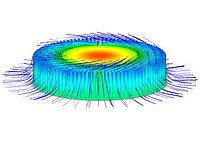
Photo from wikipedia
Abstract A key aspect for achieving the optimum performance of loop heat pipe devices is to ensure that the wick structure and its appropriate assemblage perform within their original thermal-physical… Click to show full abstract
Abstract A key aspect for achieving the optimum performance of loop heat pipe devices is to ensure that the wick structure and its appropriate assemblage perform within their original thermal-physical design specifications. When manufacturing primary wicks, powder sintering is the most commonly used technique, due mainly to the economic costs associated with such processes. However it presents a drawback associated with the randomness of the internal wick structure that can result in an irregular liquid-vapor interface, penalizing its permeability and causing unsteady fluid-thermal behavior in the whole device. This work, implements the 3D printing technology known as “Selective Laser Melting” for the fabrication of the primary wick. Its advantage is that it controls the geometric size of the internal wick passages, aiming to achieve an optimal design according to the specified requirements. The key roles played by both fluid charge and ambient temperature are carefully addressed, so while lower mass charge is preferable for small loads, at the same power, the operating temperature is nevertheless higher for lower ambient temperatures. Finally, a case study is conducted with a loop-heat pipe for cooling an 80 W LED street lamp equipped with the wick that is characterized in this study. The case study addresses an exhaustive analysis of the improvements, in terms of selected working fluid and the way of fabrication of the wick through the use of a novel technique, where a restrictive condition in the maximum temperature of the fluid was imposed in comparison with other loop heat pipes of similar characteristics, equipped with non-optimized commercial wicks. It highlights the relevance of this optimization procedure in the performance from the start-up behavior under different working conditions: input power, ambient temperature and mass charge.